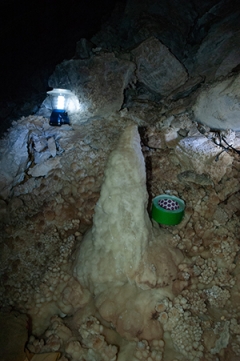ASU study examines why some environments have more species than others
Why do some regions of the world have so many species of plants while others have so few?
This is one of the great enduring research questions in the biological sciences, and there have been many ideas put forward as an answer.
One idea is that regions that have had relatively stable climates through the millennia will have greater numbers of species. In contrast, dramatic climate change of the type we are experiencing today will drive species extinct, thus winnowing away diversity.
A study published in the Journal of Biogeography by an international transdisciplinary team of scientists, led by Arizona State University researchers Curtis Marean and Kerstin Braun, provides compelling evidence for this idea from the study of climate change from stalagmites.
The Cape Floristic Region on Africa’s southern tip has one of the most diverse floras on Earth despite having infertile soils and hot, dry summers. Normally, more productive, wetter regions have more diversity.
“To understand the reasons for this diversity, we need to develop long climate records from a large sample of regions in the world and study their climate stability relative to their floral species diversity,” said Marean, who is an ASU Foundation Professor, a research scientist with the Institute of Human Origins and School of Human Evolution and Social Change, and a Nelson Mandela University (South Africa) Honorary Professor.
To do that, Marean developed a program to find and study stalagmites throughout the Cape of South Africa and collaborate with a transdisciplinary team of scientists including South African botanist Richard Cowling of Nelson Mandela University.

Topography of South Africa with the location of the cave and major cities. Gray shading indicates the Cape Floristic Region and a dark grey outline marks the area dominated by winter rainfall (>60% rainfall between April and September). Image by Kerstin Braun PhD.
Why stalagmites?
Stalagmites can preserve long records of climate change; they grow in caves, sometimes for over tens to hundreds of thousands of years, and they preserve changes in stable isotopes of oxygen and carbon that depend on the rain water and vegetation above the cave site. They can also be accurately dated with a technique called uranium-thorium dating.
Marean and colleagues rescued a set of stalagmites destined for destruction by mining at Cape Limeworks in Robertson in the Cape Floristic Region. The stalagmites, which grew between about 670,000 and 240,000 years ago, were then studied by Braun, an assistant research scholar in the Institute of Human Origins and lead author of the study.
“We compared the Cape Limeworks records to those from other sites in similar summer-dry, Mediterranean-type climates but with lower diversities than the Cape Floristic Region," Braun said. "The results clearly show that the southwestern Cape was climatically much more stable through glacial-interglacial changes than the other areas."
The results are significant because the Cape experiences a Mediterranean climate with dry, hot summers and mild, wet winters. This means that temperatures are generally low during the main growth season.
Common hypotheses for the evolution of diverse floras were developed to explain the high diversity of the wet tropics and often postulate that warm and wet conditions are needed for the evolution of high diversity — for example, through increasing the speed of metabolism or interactions between organisms.
These hypotheses don’t apply in arid Mediterranean regions, yet many of the floras in those regions exceed those of many tropical rainforests in the number of species per area.
Researchers from Mediterranean climate regions have long recognized their exceptional floras and proposed alternative hypotheses for their evolution. Cowling thinks that environmental stability and low extinction rates are a major factor in the accumulation of species.
The study is the first time that a paleoclimate reconstruction spanning several hundreds of thousands of years backs up these claims.
Cowling notes that “These findings show that relative climate stability over evolutionary time explains patterns of diversity in Mediterranean regions: The more stable, the richer the flora, with the Cape at the head of the pack. It’s possible that the climate stability theory applies also to tropical rainforest regions.”
“Our results," said Marean, “provide a dire warning of the downstream impacts of rapid climate change that we are now experiencing. Our study shows that rapid climate change annihilates plant lineages, so the human-induced rapid climate change we see today will do the same with horrific consequences for the animals and humans that rely on those plants.”
This research was funded by the USA National Science Foundation, the Hyde Family Foundations, the John Templeton Foundation, Arizona State University, the European Commission, the South African National Research Foundation and Nelson Mandela University.
